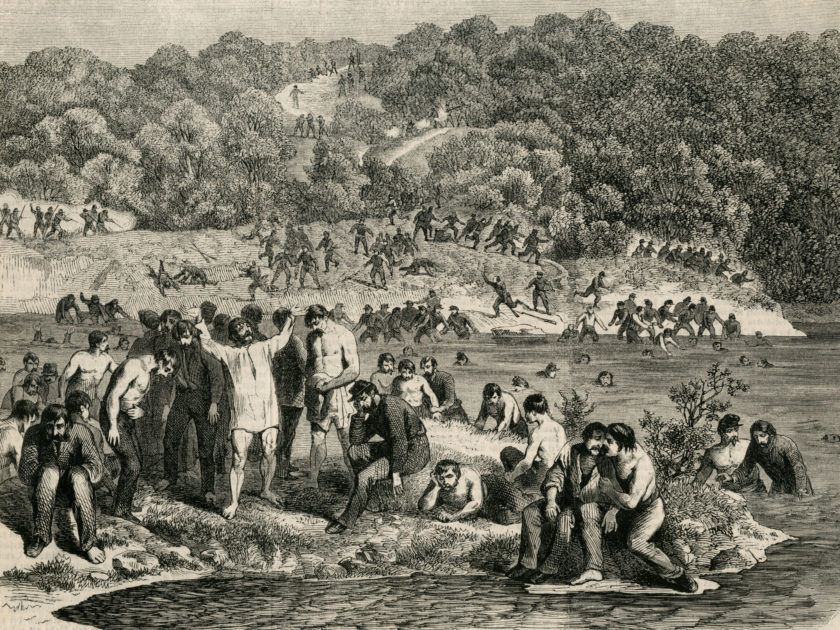By James A. Morgan and Ken Fleming
The Battle of Ball’s Bluff was the result of a faulty reconnaissance report made by an inexperienced officer.
On the evening Oct. 20, 1861, Capt. Chase Philbrick of Company H, 15th Massachusetts Infantry, led a 20-man reconnaissance patrol across the Potomac River and into Virginia. His purpose was to determine whether Union troop movements near the river earlier in the day had prompted any significant Confederate activity.

In an open field about a mile from the river, and near the farm of the widowed Margaret Jackson, the inexperienced Philbrick spotted what he thought to be an enemy camp. But the rolling terrain and the shadowy evening light combined to cast a row of trees as the illusion of a row of tents. Without checking further, Philbrick ordered his patrol back across the river and reported the existence of this “camp” to Brig. Gen. Charles P. Stone, his division commander.
On orders from Stone, Col. Charles Devens, commander of the 15th, dispatched a 300-man force to raid this non-existent camp. The crossing took several hours, but was accomplished by dawn on Oct. 21. Stone provided a diversion for the raiding party by sending 30 troopers from the 3rd New York Cavalry to Edwards Ferry, three miles downriver from Ball’s Bluff.
The raiding party, advancing from the Bluff, soon discovered Philbrick’s mistake. Rather than return empty-handed however, Devens deployed his men along a tree line near the Jackson house, and sent word to Gen. Stone that no camp existed. He then asked for further instructions, electing to hold his position–a determination that led to the early-war Battle of Ball’s Bluff.
Upon hearing of the reconnaissance report about the camp, Stone informed Devens that he sent the remainder of the 15th across the river. He instructed the colonel to turn the raiding party into an expanded reconnaissance, and probe in the direction of Leesburg. Stone then called on the commander of his Third Brigade, Col. Edward D. Baker, a U.S. senator and close friend of President Abraham Lincoln, to take command of the force at Ball’s Bluff, evaluate the situation, and use his discretion about advancing more men across the river. Unknown to Stone and Baker, however, Devens’ original raiding party had already encountered Confederate pickets. By 8:00 a.m., the 15th was engaged with soldiers from Company K of the 17th Mississippi Regiment. The fighting had commenced without Stone’s knowledge.

Each side gradually reinforced throughout the day. Three small actions took place during the morning between Devens’ men and an increasing number of Confederates from several infantry regiments, including the 8th Virginia and 17th and 18th Mississippi. The struggle gradually moved from the Jackson house toward the river, and to the field and woods before Ball’s Bluff. What started as a small reconnaissance patrol rapidly had developed into a full-blown action. Despite appearances, expectations and the flawed interpretations of many historians, none of what occurred had been previously planned. But as a result of Capt. Philbrick’s understandable error, the Battle of Ball’s Bluff took shape.

Involved on the Union side were the 15th and 20th Massachusetts infantries, the 42nd New York Infantry, the 1st California Infantry (later known as the 71st Pennsylvania), a section of Company I of the 1st Rhode Island Light Artillery, the 1st U.S. Artillery, and Company K of the 2nd New York State Militia’s artillery. Facing the federals were the Confederate 8th Virginia Infantry (comprised mostly of Loudoun County men), the 13th, 17th, and 18th Mississippi infantries, and portions of several independent Virginia cavalry companies, later incorporated into the 4th and 6th Virginia cavalries. Overall Confederate commander Col. Nathan “Shanks” Evans directed his forces from his Leesburg headquarters, between Ball’s Bluff and Edwards Ferry.
Some 1,700 men engaged on each side, though officers on both sides reported being heavily outnumbered by the enemy.
Col. Baker was killed late in the afternoon, and remains the only U.S. senator ever to die in combat. Col. Milton Cogswell of the 42nd New York Infantry then took command of the Union forces. But by this time, the opportunity for a victory had passed. Shortly after, fresh Confederate troops arrived and overwhelmed the federals.
The Battle of Ball’s Bluff was a small skirmish of no real military significance. But the death of a U.S. senator instilled the encounter with great political weight, and led to the formation of the Joint Committee on the Conduct of the War in early December. Moreover, happening as it did so early in the war before the real bloodbaths of 1862, this small fight near Leesburg achieved great, if only temporary, notoriety on both sides.

Most of the engagements in 1861 were relatively small. Even First Manassas, where some 70,000 men took the field, paled in comparison by the new standard set a year later. And, like Ball’s Bluff, the fighting during that first year of the war held only limited military consequence. Still, Ball’s Bluff stood out for several reasons other than Baker’s death.
First, it was the third Federal defeat in a row beginning with Manassas. Confederate victories at Manassas, Wilson’s Creek and Ball’s Bluff drove home the point that the war would not be short or easy. Senator Baker’s death underscored this harsh reality.
In addition, Ball’s Bluff was fought 40 miles northwest of Washington, D.C.—too close for the comfort of many northerners. In hindsight, the battle proved a precursor to the much larger scares that Antietam and Gettysburg created later in the war. And, with most of the fighting confined to the western theater at the time, Ball’s Bluff became the focal point for media attention in the east. Stories about the engagement filled newspaper pages well into the winter of 1861-62.
Lastly, Ball’s Bluff was an overwhelming Confederate victory; proportionally as large a victory as either side had achieved early in the war. The federals suffered almost 59 percent killed, wounded and captured. Confederate casualties totaled about 18 percent, and many fewer Confederates were actually killed—36 Confederate vs. 223 Union.
The result gave Southerners a good reason to be exhilarated, especially following other early victories. But at the same time, the defeat represented a serious blow to northern morale and became known in the north as “that cursed Ball’s Bluff.”
James A. Morgan is a life-long Civil War enthusiast. He was born in New Orleans where his family settled after the family plantation, Morganza, about 40 miles upriver from Baton Rouge, was destroyed during the War. He is the author of A Little Short of Boats: the Battles of Ball’s Bluff and Edwards Ferry, October 21-22, 1861. He is also co-founder and past president of the Friends of Ball’s Bluff, and serves on the board of the Mosby Heritage Area Association. He and his wife live in Lovettsville, Va.
Ken Fleming has been an avid student of Civil War history and collector of all things Balls Bluff since the age of nine. An eighth generation Loudoun County Virginian, his great grand father fought with the 8th Virginia Infantry and helped capture the two Union mountain howitzers used during the Battle of Ball’s Bluff. Ken has received several history awards for his work and extensive research, with several of his articles now in publication.
SPREAD THE WORD: We encourage you to share this story on social media and elsewhere to educate and raise awareness. If you wish to use any image on this page for another purpose, please request permission.
LEARN MORE about Military Images, America’s only magazine dedicated to showcasing, interpreting and preserving Civil War portrait photography.
VISIT OUR STORE to subscribe, renew a subscription, and more.

